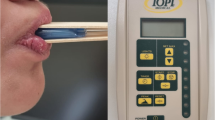Abstract.
Background:
Oral comfort, speech, mastication and swallowing, as well as oral hygiene were to be evaluated in a prospective longitudinal study before and after insertion of lingual brackets.
Patients and Method:
22 patients (five male, 17 female, mean age 34.7 years, SD 10.4) were enrolled in the study and filled in a standardized questionnaire directly before placement of lingual brackets (T0), within 24 hours thereafter (T1), and 3 months (± 1 week) later (T2). At both T1 and T2, treatment was confined to the upper arch.
Results:
In comparison with T0, significantly poorer results were recorded at T2 for the parameters “restriction of the tongue space”, “lesions to the tongue”, “tongue position”, “subjective and semiobjective rating of articulation”, “chewing”, “biting” and “oral hygiene”, although significant improvements, i. e. adaptations, had been recorded from T1 to T2 with the exception of the parameters “tongue space”, “tongue position”, “chewing”, ”biting” and “oral hygiene”. At none of the registration timepoints was fluid intake impaired by the lingual brackets.
Conclusions:
The results of the present study suggest that detailed briefing on the extent and duration of potential impairments in oral comfort, functions and hygiene is advisable prior to the insertion of lingual brackets.
Zusammenfassung.
Hintergrund:
In einer prospektiven Longitudinalstudie sollten oraler Komfort, Sprach-, Kau- und Schluckfunktion sowie Mundhygiene vor und nach Applikation von Lingualbrackets evaluiert werden.
Patienten und Methode:
22 Patienten (fünf männlich, 17 weiblich, Durchschnittsalter 34,7 Jahre, SD 10,4) wurden in die Studie inkludiert und beantworteten unmittelbar vor Behandlungsbeginn (T0), innerhalb von 24 Stunden danach (T1) und 3 Monate (± 1 Woche) später (T2) einen standardisierten Fragebogen. Zu T1 und T2 wurde ausschließlich im Oberkiefer behandelt.
Ergebnisse:
Im Vergleich zu T0 bestanden zu T2 noch immer signifikante Verschlechterungen für die Parameter „Einengung des Zungenraums“, „Verletzungen der Zunge“, „Zungenlage“, „subjektiv und semiobjektiv beurteilte Lautbildung“, „Kauen“, „Abbeißen“ und „Zahnpflege“, obwohl von T1 zu T2 signifikante Verbesserungen, das heißt Adaptationen zu konstatieren waren. (Von diesen Verbesserungen ausgenommen waren die Parameter “Einengung des Zungenraums“, „Zungenlage“, „Kauen“, „Abbeißen“ und „Zahnpflege“.) Die Aufnahme von Flüssigkeiten wurde durch die Lingualbrackets zu keinem Untersuchungszeitpunkt beeinträchtigt.
Schlussfolgerung:
Vor der Applikation von Lingualbrackets empfiehlt sich gemäß den Ergebnissen der vorliegenden Studie eine Maximalaufklärung über Ausmaß und Dauer möglicher Beeinträchtigungen in oralem Komfort, oraler Funktion und Mundhygiene.
Similar content being viewed by others
Author information
Authors and Affiliations
Corresponding author
Rights and permissions
About this article
Cite this article
Hohoff, A., Fillion, D., Stamm, T. et al. Oral Comfort, Function and Hygiene in Patients with Lingual Brackets. J Orofac Orthop 64, 359–371 (2003). https://doi.org/10.1007/s00056-003-0307-6
Received:
Accepted:
Issue Date:
DOI: https://doi.org/10.1007/s00056-003-0307-6



